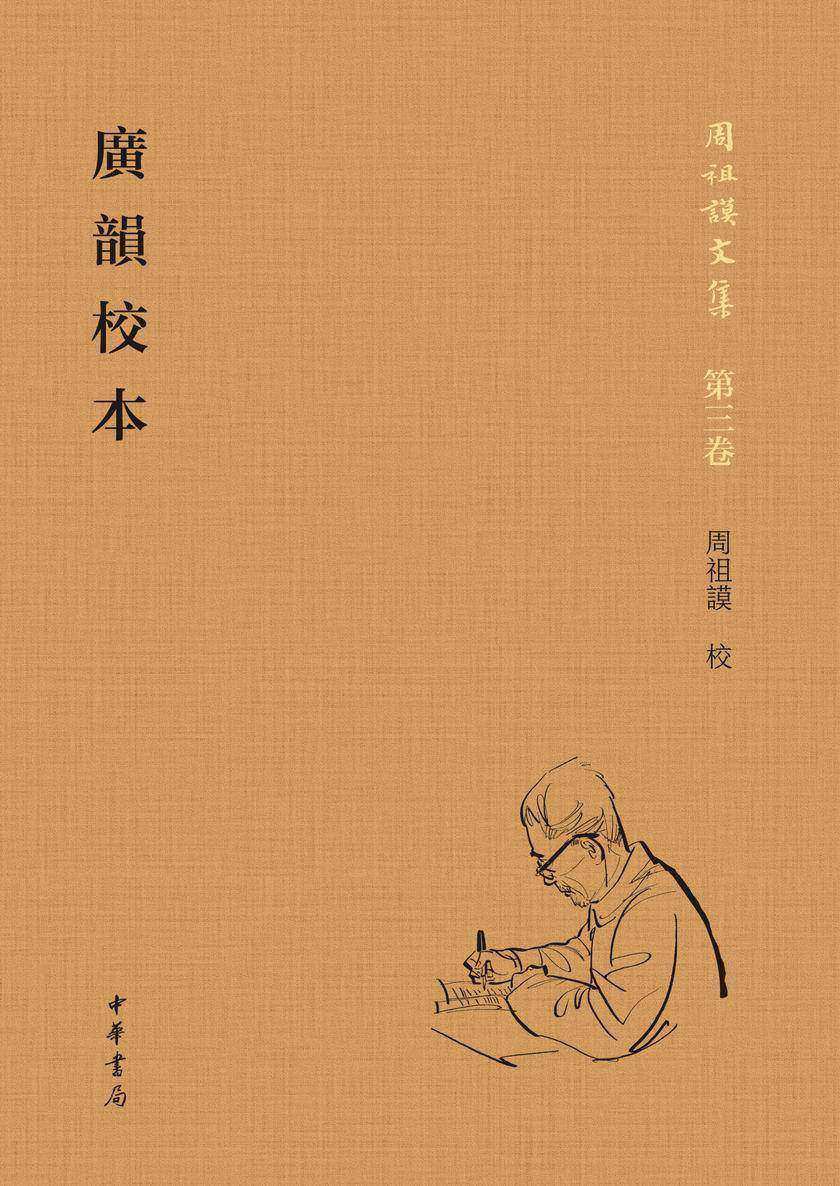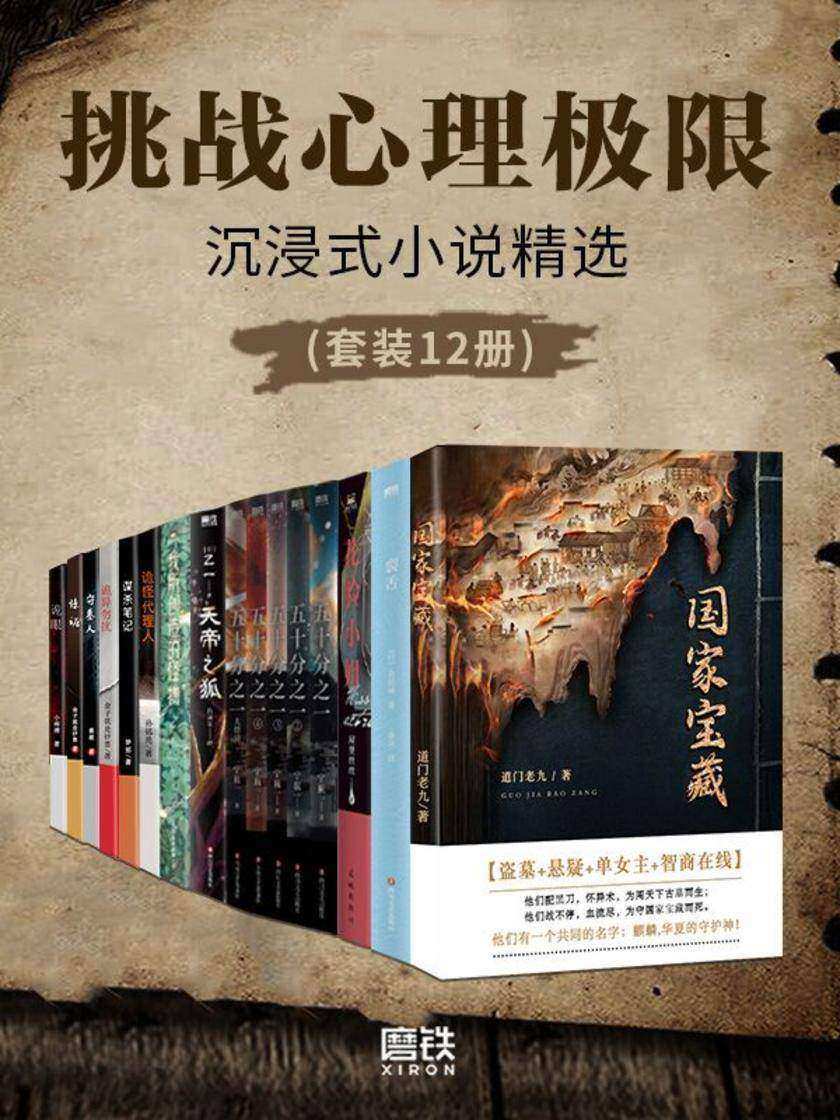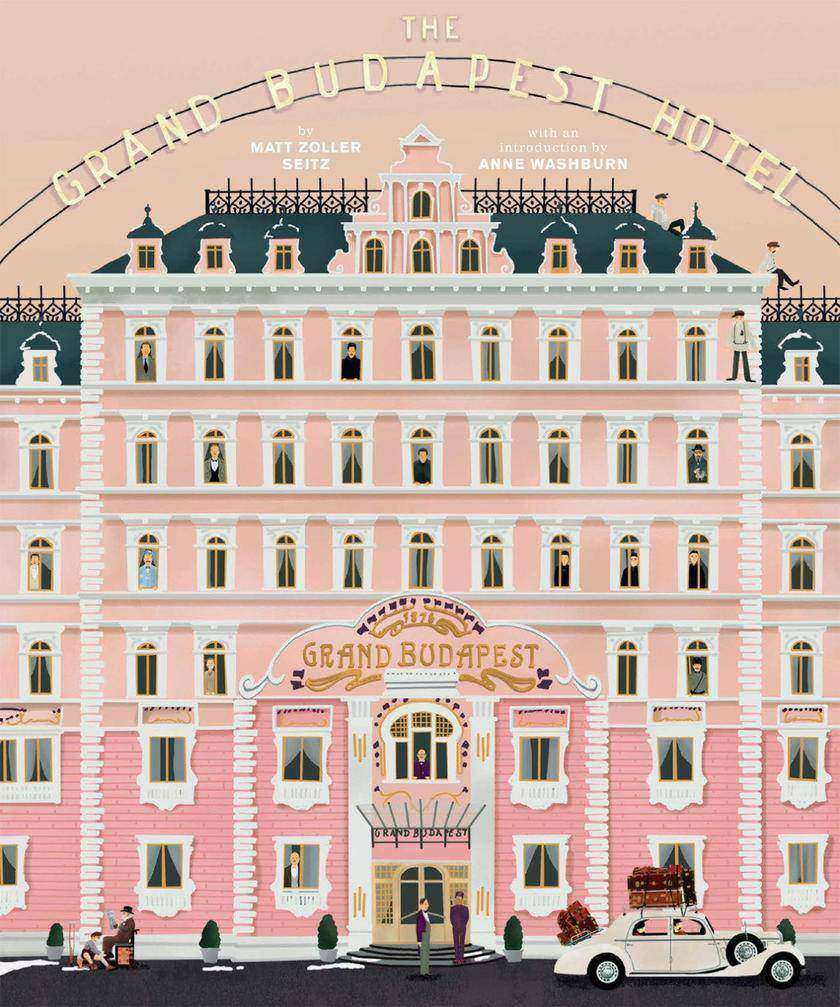
读客知识小说:造物者之歌(全6册)(现代都市版“女娲造人+神笔马良”!这里是造物者的异世界,用文字便可以创造奇特生命)
¥288.00
神奇的造物术横空出世,人类迎来了一个前所未闻的新纪元,一支魂笔,一管点睛,落笔于诞生纸,投诸于孕生水——一个全新的生命纸人就此诞生。掌握造物术的那部分人成为了高高在上的神,没有特殊技能的纸人则沦为社会的*底层,整个社会由此形成了等级森严的生命秩序。 十六岁少年简墨,一个处于金字塔底端的纸人,和专断的养父生活在单调乏味的六街。直到一场谋杀从天而降,简墨平静的生活被打破,他进入到传授造物术的神奇学校,结识了一群身份各异的生死伙伴。与此同时,他发现自己身上隐藏着巨大的秘密和使命。一场能力与信念、自由与尊严的较量正在悄然展开…… 翻开本书,走进全新的幻想纪元,见证天生异能的神奇物种和不甘命运的誓死反抗!

西明东夏:唐代长安西明寺与丝绸之路(精)全二册 中华书局出品
¥288.00
西明寺是位于唐代首都长安城延康坊的皇家寺院,是唐代强盛之时的众寺之首,也即所谓“国家大寺”,不仅是僧团日常活动的载体,还集译经的场所、著述的所在、外国僧人的留学重地、皇家礼仪活动乃至市民文化活动的场所等功能于一身,是一个不断吸引周边宗教与世俗精英的知识朝圣的中心,其辐射范围笼罩了整个周边地区与国家。玄奘、不空、道宣、慧琳等佛教精英,都曾活跃于此。 《西明东夏:唐代长安西明寺与丝绸之路》以长安西明寺为切入点,从“帕米尔高原—敦煌—长安”、“西明寺—杭州—日本”、“南海—广州—长安”三条线路,对该寺在长安佛教乃至中国佛教发挥的作用进行了梳理,清晰呈现了陆路和海上丝绸之路上的长安文明。其中神圣与世俗、超世离尘与财富金钱、政治与宗教、精神与物质、中土与异域、东方与西方完美地交融,折射出中古时期王权与教权间的微妙关系及神圣同世俗间的互动,可使读者深入了解通过丝绸之路而来的佛教文化对中华文明的影响,理解中华文化鼎盛时期海纳百川、容摄万有的博大胸襟。 本书分“研究编”与“史料编”两编,深入的研究与翔实的史料互为表里,相辅相成。

山海无界:东方遇到西方
¥288.00
《山海无界:东方遇到西方》以《山海经》原文内容为母题,由奈目·鹏飞山海经工作室牵头策划,委托知名撰稿人执笔创作,对《山海经》内容行深解读,由书中的珍禽异兽、上古神人、奇花异草演绎出情致动人的故事,再配以画家贺鹏飞先生的精美油画作品,令西方绘画与东方故事交织碰撞,构思奇幻新颖,情节引人胜,深挖掘山海经文化,向读者展示不一样的“山海经”世界,具有很强的可读性和观赏性。本书是奈目·鹏飞山海经工作室策划推出的*部关于《山海经》文化的大型图书。

广韵校本(精)全二册--周祖谟文集 中华书局出品
¥288.00
《广韵》是中古时期重要的韵书之一,反映了中古时期的语音系统。周祖谟先生以他丰厚的文献学和音韵学素养,加以校勘,极便学界使用,是经典的《广韵》整理成果之一。这次我们以中华书局2011年版为底本,影印保留《广韵校本》及《广韵校勘记》手写原貌。《广韵四声韵字今音表》本次改为电脑录排,便于观览。另收《广韵略说》《我和广韵》《影印鉅宋广韵前言》《广韵跋尾二种》《宋代汴洛音与广韵》等五篇相关研究、序跋类文章。新编了针对《广韵校本》字头的《音序索引》和《笔画索引》,附于上册之后,供读者查检。 ?

日本人眼中的世界
¥287.78
《逆说美国的民主》 美国以自由的代言人自居, 然而以民主思想为基础的政治制度、司法体制和社会文化却暴露出越来越多的弊端。本书以卡特里娜飓风袭击新奥尔良为切入点,展现了一幅美国社会纵断式的景观图,灾害暴露出的贫困、不平等、政治分裂、种族壁垒等问题始终困扰着美国的政治家和普通人。美国式民主是否具有本质上的缺陷?以“他者”的视角,着眼于美国的政治困境,日本学者尝试解构美国式民主。 《古代中国的文明观》 今天人们定难想象,上古时代,黄土高原曾是一片郁郁葱葱的森林。荒漠化源于水土流失,水土流失始于大量砍伐森林。在三千年前的黄河流域,文字出现不久,城市建设方兴未艾,面对飞速发展的文明,古老的巫术与神灵失去力量,古代思想家忧喜参半,纷纷设想人类的明天。儒家相信天地自有能力供养人类,鼓励人们在吃穿用度的每一个方面彰显阶级差别,是为礼;墨家相信节约是解决资源短缺的唯#一方法,谴责奢靡浪费和不义之战;而道家探索天地、自然规律,看到了环境承受能力的极限,提倡“小国寡民”。此后,儒家成为官学,墨家销声匿迹,道家则以其形而上的特性演化为宗教、哲学,成为中国人替代性想象的源泉。如何应对文明发展——正是围绕着这个问题,诸子百家建构起各自的理论体系。自然与文明的冲突逼迫人类反思,在希望与危机并存的时代,我们依然可以从先人的遗产中发现启示。 《近代朝鲜与日本》 19世纪末,为打开“隐士之国”朝鲜的大门,欧美列强轮番侵扰,主政的大院君坚决攘夷,拒绝通商传教,树立斥和碑,告诫子民“洋夷侵犯,非战则和,主和卖国”。然而1875年,日本制造江华岛事件,率先与朝鲜缔结不平等条约。此后,朝鲜陆续与欧美列强及清国签订条约,朝鲜半岛沦为各国势力的角逐场:日本计划吞并朝鲜,以朝鲜为跳板侵略大陆;清国希望维持与朝鲜的宗藩关系,将朝鲜作为抵御侵略的防波堤;美国希望打开朝鲜国门,获取贸易利益;俄国希望在朝鲜扶植势力,牵制日、美、英三国……在各国势力面前,小国朝鲜的命运如风前灯火。为了延续国祚,保全儒家文明,朝鲜只能在夹缝中求生。 《日本的诞生》 早期日本的历史,只能从中国的史书和东亚各国的古代文献中略窥一二。本书从“日本”国号入手,按照“倭”到“日本”的发展脉络,讲述了日本作为一个国家诞生的过程。其间,派遣遣隋(唐)使、发现金矿、引进姓氏制度、建立律令制、佛教传入、创造假名文字等大事件,都对日本的历史进程起到了不可忽视的推动作/用。而日本与中国、朝鲜半岛各国的交流尤为重要——既有文化贸易往来,也有纷争与战乱。早期日本国家的特点、日本民族的个性正是成形于这种复杂的国际关系,今日日本与周边国家的矛盾,其根源也深埋于这段古老的历史之中。 《日本的神话》 日本的神话,见载于《古事记》《日本书纪》和记录日本古代各国的《风土记》。不同于华/夏民族发达的史书写作和理性文明,日本人直到战前还相信神话中的记载是真实的历史。而本书将神话看作文学作品,介绍了其中z/u/i有趣的部分,探索了其背后隐藏的历史事实。民间传说、诗歌、戏剧,神话的文体多种多样;世界的起源,英雄的传奇,天皇的“族谱”,神话的内容包罗万象。这是一个由绮丽想象构筑的世界。崇拜太阳神的民族虽多,女性的太阳神却很少见;创世之神虽然必不可少,男女一对的却很稀有;浪漫奔放的爱情故事虽多,兄妹姐弟通婚的习俗却很独特;现代日本人拘谨内向,古代神话中却充满露骨的性暗示。大和先民被茫茫大海包围,逐渐发展出独树一帜的岛国文明。今日我们目之为怪的现象,或许便扎根于这段独特的历史之中。 《日本文化关键词》 孔子云:“未知生,焉知死。”中国文化向来强调人的一生要立功立德,而对终要面临的“死亡”多避讳不谈。在禅宗思想中,生即是为了死,生死不过是循环往复的过程。在日本文化、宗教、艺术、思想领域,禅宗的“无常观”浸透尤深。镰仓歌人西行面对着血海尸山吟咏出了花月之美;南北朝歌人吉田兼好厌倦了名利风雅后写下“物皆幻化,何事暂住”;能剧大家世阿弥在探讨能剧艺术与人生时说:“花将萎,方为有趣。”这是一本关于“无常”的日本文化史。作者藤田正胜从几个关键词巧妙切入,向我们展示了日本歌人、俳人、僧禅对于生死的思考,诠释了日本文化的真义。 《日本的汉字》 古代日本人从中国带去汉字,也带去了文明与开化。汉字被用于记录日语,在日本人的手中,逐渐发展出不同于中文汉字的特点。有些汉字按照古汉语发音,有些按照日语发音;有些字写法与汉语相同,意义却不同;日本人为了方便书写、表义,甚至创造出新的汉字,称为“国字”;为了翻译西语,创造出新的汉语词汇,后来又传回中国,成为今天我们的常用词。在日本,汉字的形态丰富多样,有广为流传的错字,有无人看懂的“幽灵文字”,有特定阶层使用的语相文字,也有文学作品中出现的个人造字,还有广告招牌上的艺术字……日本汉字学家通过大量的数据统计、资料搜集和田野调查,带领我们走进这个既陌生又熟悉的文字世界。 《京都》 京都是一部活生生的“日本史”。日本再无一座城市像京都这样,布满历史的沧桑与印迹。漫步于京都街巷,我们能从棋盘格的城市格局中看到平安贵族对大唐的向往,在六波罗看到《平家物语》的遗迹;转过街角,又在银阁寺的茶室里发现茶道与花道的起源;而在醍醐寺,樱花树下萦绕着丰臣秀吉未做完的梦。神社、寺庙、庭院、泉池,京都的美,不仅在于风景的美,更在于历史的厚重。以时间划分空间,以空间展现时间,在不同的地点,探寻不同的历史。京都大学教授林屋辰三郎,凭着对京都的熟稔和专业,解读古都,从一座城市一窥一个国家的历史。 《格差社会》 父母的职业决定子女的职业,父母的收入决定子女的收入,父母的阶层决定子女的阶层,寒门再难出贵子?私立学校贵族化,公立学校精英化;职业教育缺失,大学生毕业即失业;年轻人没有存款,养老金杯水车薪;人人平等的机会被剥夺——教育、就业等各个方面的不平等与阶层差距都在扩大。日本经济学会会长,用翔实的数据揭示了一直不受重视的年轻人失业、女性贫困、老年人无依无靠等格差社会的严峻状况,并提出解决之道。作者不拘于经济学家的立场,以人文主义的关怀,试图为弱势群体发声。 《过劳时代》 从欧洲到美国,从日本到发展中国家,人们曾经期待的“休闲型社会”并未到来,“过度劳累的时代”却开始了。为何生产力在发展,人们却越来越疲于奔命?物质享受越来越丰富,业余时间越来越少。其根源在于社会结构还是个人心理?贫富差距、交通安#全、性别歧视……过劳现象折射出现代社会的诸多问题。本书从全#球化、信息技术、消费社会、管制放松等角度,分析了过劳背后的社会动向,指出现代人的普遍心理特征,并介绍了荷兰、美国以及日本等国家为解决过劳现象而作出的尝试。关西大学经济学家森冈孝二以大量数据、详实案例立论,集十数年研究成果之大成,为我们披露过劳时代的实貌。

理想国M译丛 日本印象系列(全五册)
¥287.00
《活着回来的男人》是部以普通人的视角记述二战前后日本生活史的著作。 书中主人公小熊谦二(作者的父亲),出生于1925年,十九岁被征兵送往中国东北,后遭苏联拘留于战俘营,在严酷的西伯利亚劳动了三年。活着返回日本后,谦二在不断更换工作时,染上当时视为绝症的肺结核。从二十五岁到三十岁,人生失落的光景在疗养所中孤独地度过。失去半边肺叶的谦二,以三十岁“高龄”重归社会,幸而赶上日本经济高速增长的浪潮,得以从“下层的下层”爬到“下层的中层”。升为银发族后,他甚至与身在中国延边的“原朝鲜日本兵”吴雄根共同成为原告,向日本政府发起战后诉讼赔偿。作者以平实的叙事和阔的视角记录了自己的父亲作为一个普通日本兵的生命轨迹,同时融同时期的经济、政策、法制等状况,形成了一部“活生生的二十世纪史”。

心理学有温度(严肃面孔后的温暖心理学)(套装共13册)
¥286.99
《心理学有温度》(套装共13册)包含《行为心理学》《德国精英教育心理学》《潜意识与心灵成长》《哈佛教授的心理学原理》《行为心理学2》《人性心理学》 《心理学的盛宴》《情绪心理学》《行为心理学3》《实验心理学》《动机与人格》《人性能达到的境界》《存在心理学》。 《心理学有温度》(套装共13册)收录了心理学相关各个理论区域的经典著作,内容涵盖了基础理论、实践应用,以权威理论为根基,从实际案例着手,帮助读者们剖析自己、相信自己,充分开发潜在能力,战胜恐惧、焦虑,走向真正的自我。


顶级智慧:大佬秘而不宣的生存之道(共8册)
¥286.99
套装共8册,分别为《*智慧Ⅰ——听李嘉诚讲经商之道》《*智慧Ⅱ——听巴菲特讲投资之道》《职场道中道》《做派》《欲望》《成功是熬出来的》《人生靠自己打造》《格局大了,事就成了: 拓宽生存空间,突破发展困境的大智慧》

职场故事:难搞的甲方千奇百怪(共7册)
¥286.99
职场需要什么样的人,谁能在职场上立于不败之地,谁又将黯然离去?套装共7册,分别为《HR日记》《HR日记2》《裁员专家》《律所故事》《谈判精英》《莫小可的陪诊人生》《*佳Offer》

ZUI会讲故事的人:西德尼·谢尔顿作品精选集(共5册)
¥286.99
西德尼·谢尔顿作品精选:《谋略大师》、《午夜的另一面》、《假如明天来临》、《朱门血痕》、《天使的愤怒》

沉浸式小说精选(套装12册)
¥285.87
套装包括:《国家宝藏》《裂舌》《花脸小姐》《五十分之一.全5册》《天帝之狐》《我所创造的怪物(新版)》《诡怪代理人》《谋杀笔记》《诡异勿扰》《守墓人》《惊魂》《诡眼》

杨照作品集(套装9册)
¥285.75
此次收录杨照作品集有以下9部作品: 1.《史记的读法:司马迁的历史世界》——以“历史式读法”还原当时的社会背景,解释重大事件的因由,以“文学式读法”去接近司马迁的视角、态度与理念,把经典带入今天的时空。 2.《呼吸:音乐就在我们的身体里 》——走进那个时代,走进音乐家的人生,知晓那些让音乐变得如此有魅力的秘密,从而能更好地感受乐曲中的动人之处。 3.《打造新世界:费城会议与<美国宪法> 》——讲解美国宪法的条款,讲解了以这套宪法为依据的美国政治制度是怎样、如何运作,并讲述美国宪法制定背后的思想渊源、历史情境、现实利益考量和斗争妥协。 4.《以平等之名:托克维尔与 论美国的民主》——走入文本的世界,深入讲述清教徒精神如何塑造美国民主,美国的公民自由又如何与法国的天然自由不同。 5.《寻路青春》——一本“记忆地志”,文笔细腻又朴实的杨照先生通过重新梳理自己的青春往事,带领读者回到了三十多年前的台湾,展现了那一代人在成长中对人生和未来的思考。 6.《想乐:聆听音符背后的美丽心灵》——杨照介绍了自己喜爱的100首西方古典乐曲,包括晶莹清响的钢琴独奏曲、深沉隽永的大提琴曲、层次丰盈的小提琴协奏曲等等。 7.《我想遇见你的人生》——以类似对话、日记、独白的散文诗形式抒写父女俩日常生活中的点点滴滴和人生感悟。 8.《迷路的诗》——《迷路的诗》以忏情开始,回忆作者在高中时代的浪漫与叛逆。 9.《故事照亮未来:通往开放社会的100个观念》——杨照从千头万绪的故事和现实中提取出一百个关键概念,如协商、和解、法律、制度、身份、记忆、媒体……

Wes Anderson Collection: The Grand Budapest Hotel
¥285.57
This companion to the New York Times bestselling bookThe Wes Anderson Collectiontakes readers behind the scenes of the Oscar(R)-winning filmThe Grand Budapest Hotelwith a series of interviews between writer/director Wes Anderson and movie/television critic Matt Zoller Seitz. Learn all about the films conception, hear personal anecdotes from the set, and explore the wide variety of sources that inspired the screenplay and imageryfrom author Stefan Zweig to filmmaker Ernst Lubitsch to photochrom landscapes of turn-of-the-century Middle Europe. Also inside are interviews with costume designer Milena Canonero, composer Alexandre Desplat, lead actor Ralph Fiennes, production designer Adam Stockhausen, and cinematographer Robert Yeoman;essays by film critics Ali Arikan and Steven Boone, film theorist and historian David Bordwell, music critic Olivia Collette, and style and costume consultant Christopher Laverty; and an introduction by playwright Anne Washburn.Previously unpublished production photos, artwork, and ephemera illustrate each essay and interview.The Wes Anderson Collection: The Grand Budapest Hotel stays true to Seitzs previous book on Andersons first seven feature films,The Wes Anderson Collection,with an artful, meticulous design and playful, original illustrations that capture the spirit of Andersons inimitable aesthetic. Together, they offer a complete overview of Andersons filmography to date.Praise for the film,The Grand Budapest Hotel: Four Academy Awards(R), including Costume Design, Music - Original Score, and Production Design;Nine Academy Award nominations, including Best Picture, Directing, and Writing - Original Screenplay; Best Film - Musical or Comedy, Golden Globe Awards; Best Original Screenplay, BAFTA, WGA, NYFCC, and LAFCA AwardsPraise for the book,The Wes Anderson Collection: ';The Wes Anderson Collectioncomes as close as a book can to reading like a Wes Anderson film. The design is meticulously crafted, with gorgeous full-page photos and touches . . .' Eric Thurm,The A.V. Club Also available from Matt Zoller Seitz: Mad Men Carousel, The Oliver Stone Experience, The Wes Anderson Collection: Bad Dads, andThe Wes Anderson Collection.

思维认知书系(套装10册)(探索的思维本质,开启认知的大门,摒蔽行为决策的噪声,精准解决学习工作生活的所有难题)
¥285.30
噪声 想象一下,两名医生对相同的病人给出了不同的诊断;两名法官对犯了同罪的嫌疑人给出了不同的判决。再想象一下,同样的医生、法官或决策者做出了不同的决策,而这种决策仅仅取决于决策是在什么时间做出的。这些不同决策背后的罪魁祸首,就是“噪声”。 《噪声》是诺贝尔经济学奖得主、“行为经济学之父”丹尼尔·卡尼曼携手决策领域专家奥利维耶·西博尼和卡斯·桑斯坦共同推出的重磅新作,也是卡尼曼继畅销书《思考,快与慢》之后酝酿10年思考的quan球瞩目里程碑式巨作,行为科学领域又一重大发现。几十年来,大家都认为,偏差是导致人类判断出错的关键。但是今天,卡尼曼系统性地指出:噪声,才是影响人类判断的黑洞。 以大制胜 如何利用人的非理性说服他人?如何在说服的过程中利用视觉想象力?如何为对手贴标签,对其一击必杀?如何抢占制高点,转守为攻?如何在事情发生之前引导用户的思维?如何设计有效的口号,率先赢得客户? 在本书中,知名系列企业管理漫画《呆伯特》作者斯科特·亚当斯介绍了自己的说服理论,即如何利用“武器级”说服力,抢先竞争对手影响受众,在竞争中赢得胜利。 亚当斯认为,说服力分为三个层次,分别是“商业级”“科学级”“武器级”。其中“武器级”说服力尤其难,达到这个级别的大师非常少,几位曾经的美国总统和乔布斯在此级别;“科学级”说服力的代表是认知科学家;“商业级”说服力就是我们通常说的“影响力”“说服力”,市场营销、品牌形象管理、危机公关等用的都是这个级别的说服力。 助推2.0 桑斯坦从行为科学入手,探讨了助推作为改变工具的优势与局限。助推是一种保留选择的干预措施,由行为科学提供信息,可以很大程度上影响人们的选择。有哪些非常重要的助推手段?评估助推的标准是什么?我们究竟该往什么方向助推?什么时候助推会失败?当助推失败时,我们应该怎么做?助推与道德的关系是什么?助推与强制手段之间的关系是什么?助推是如何改变社会和我们的生活的? 我们并不总是理性的,也不总是能做出有利于自己的选择,这个时候,那些不经意的“助推”刚好可以让我们在两难中找到di三条路。 表象与本质 闻名世界的认知科学家侯世达凭借独特的智慧与天赋,联合法国心理学家桑德尔,终于向世人展示了这部极具开创性的著作,一解人类认知之谜。 人类大脑中的每个概念都源于多年来不知不觉中形成的一长串类比,这些类比赋予每个概念生命,我们在一生中不断充实这些概念。大脑无时无刻都在作类比。类比,就是思考之源和思维之火。 我们的大脑是如何工作的?所谓的类比到底是什么?我们是怎么在截然不同的情景间建立起联系的?类比在学习的过程中发挥着怎样的作用?在爱因斯坦发现相对论的过程中,类比又扮演着怎样的角色? 《表象与本质》深刻地丰富了我们对心智的理解,引领读者进入语言、思想和记忆的多彩情境,逐步揭示出隐藏的认知机制。而认知的核心就是:我们总是无意识地联系过往经验作类比。 模型思维 工作中,你在团队中是不是不可替代的人? 爱情上,为什么异地恋的相聚能够带来很大的幸福感? 游戏中,选择什么样的策略才能在各种游戏中立于不败之地? 现实社会中,为什么很少有女性成为CEO?为什么披头士的歌曲会那么流行? …… 关于这些问题的正确答案,都可以用斯科特·佩奇新书《模型思维》中的模型来回答。斯科特·佩奇是风靡quan球的“模型思维课”主讲人,有超过100万各行各业的人反复学习并从中受益。新书《模型思维》讲解了24种模型,从线性回归到随机漫步,从博弈论到合作,涵盖学习、工作、生活等方方面面——这些有趣的模型可以把任何人变成天才。 芒格说:“要想成为一个有智慧的人,你必须拥有多个模型。”这是一个数据爆炸的时代,数据充斥着我们的工作与生活,但仅拥有数据是远远不够的,必须学会让数据说话。模型就是让数据说话的秘诀,模型将帮助我们所有人从掌握信息提升到拥有智慧。 本书中的24种模型就是一个应对复杂世界的思维工具箱。各行各业、各种需求的所有人都可以根据此书建立专属于自己的思维工具箱,成为一个多模型思考者。它将帮助你整理数据、提取信息、去伪存真,在决策时让你知道选择什么样的模型,选取一个模型还是几个模型。而这是现代高手的一种大智慧。 无限的游戏 世界上有两种游戏,一种是有限游戏,一种是无限游戏。商业游戏就是一场无限的游戏。在这场无限的商业游戏中,没有所谓的时限,没有所谓的终点,更不存在所谓的赢。游戏的首要目标就是让游戏一直玩下去,只有这样,才能成为无线游戏中的头号玩家。 许多领导者总是将“赢”挂在嘴边,沉迷于“赢得竞争”,用有限思维来参与这场游戏。却不知道,在商业无限的游戏中,我们必须停止思考赢,转而思考如何建立一个足够强大、足够健康的组织,让它能够经久不衰,不被游戏淘汰。 人人都该懂的批判性思维 在现实世界中,广为流传的演讲、电视中的广告、杂志上的一篇文章,很多看似合乎逻辑的背后其实往往存在着逻辑错误。如果可以的话,我们应当反复琢磨自己和他人思考的逻辑,而这就是所谓的批判性思维。 真正的批判性思维是应用正确的逻辑去思考事情。通过学习优秀逻辑的基本原理,就不会再轻易地被混乱逻辑所愚弄。同时,你将更容易在重要的问题上提出可靠的观点。本书的目的就是阐述所有你需要的批判性思维技巧。 游戏改变人生 麦戈尼格尔揭示了近10年的科学研究成果,包括游戏、运动和心理建设。她解释了如何改变我们应对压力、挑战和痛苦的反应,如何在日常生活中培养复原力,仅仅需要一种更加“冒险”的游戏化心态。当我们玩游戏时,我们会展示出强大的心理优势,比如乐观、创造力、勇气和决心。 《游戏改变人生》包含了近100个有趣的任务,任何人都可以尝试这些游戏。另外,书中列举了很多人的真实案例,他们在面对疾病、受伤和其它重大挫折时,通过SuperBetter这款游戏变得更强大;有的人也通过这款游戏实现了减肥、跑马拉松、找到新工作等目标。 系统之美 一本简明扼要的系统思考入门指南,也是认识复杂动态系统的有力工具,帮助大家提高理解和分析身边系统的能力。小到个人问题,大到quan球性复杂挑战,本书都可以为你提供睿智的解答和洞察。 作为一本实用的入门指南,本书不仅讲解了系统动力学的基本概念、列举了常见的系统结构,还详细陈述了复杂系统的3大特征、8大陷阱与对策、12大变革方式以及15大生存法则。作者把系统思考从计算机和方程式的世界中解脱出来,以各种真实的案例,阐述了系统思考如何应用于各种现实问题,向读者展示了如何提升和应用系统思考技能——这一项普遍被认为是21世纪quan球领导力的核心技能。 作者认为,系统思考将有助于我们发现问题的根本原因,看到多种可能性,从而让我们更好地管理、适应复杂性挑战,把握新的机会,去打造一个完quan不同的自我和一个崭新的世界。 一本书,引领个人、组织与社会变革的先河,促使人们觉醒,改变看待这个世界和系统的方式,以此改变当今社会的发展进程,让大家在这个充满各种复杂系统的世界里更好地生活。 多样性红利 《多样性红利》创造性地提出多样性视角、启发式、解释和预测模型四个认知工具箱框架,并得出惊人结论:一个人是否聪明不是由智商决定的,而取决于认知工具的多样性!本书将告诉你如何应用工具箱中的工具,用多样性创造更多的红利。 查理?芒格的认知工具箱是怎么建立起来的?智能等于智商吗?人和计算机相比谁拥有更多样性的视角?多样性和能力谁更重要?拥有很优秀问题解决者的群体和由多样性人群组成的群体谁会更好地解决问题?在本书中,这些问题都将得到解答。 多样性视角、启发式、解释和预测模型让人们找到了更多更好的解决方案,让人们的预测更有价值。 多样性在4个条件下比能力更重要! 人生一切难题,视角给你答案。好的视角可以让问题变得更简单、更容易解决。任何一个问题,都存在一个可以让答案脱颖而出的视角。

智变未来:AI驱动的新纪元(套装共六册)
¥285.00
本套装包含《云上的中国3:剧变中的AI时代》《AI应用革命》《一本书掌握HR*AI技术》《轻松上手AIGC:如何更好地向ChatGPT提问》《Web3:科技新趋势》《全球互联网极简史》共6册图书。

文景·在场Presece(套装共7册)
¥285.00
《王国与权力》 1851年创刊,1896年被阿道夫·奥克斯以7万5千美金收购,《纽约时报》用一期期报道奠定了自己影响美国、影响世界的首席大报的地位。它记录了世界近现代历史中几乎所有重大的事件,而记录这些事件的《纽约时报》和《纽约时报》人则往往隐居幕后。作者特立斯从1953年开始在《纽约时报》工作了十余年。当他离开时报后,立刻就是回过头去采访自己曾经的同事,试图以时报不鼓励、不允许的方式刻画描述这个庞大的、能影响全美乃至全世界局势的机构。特立斯眼光犀利,笔触细腻,不仅在书中回溯了《纽约时报》的历史,还生动地再现了近百名时报人,以及他们在时报这个大机构中的庞杂关系,向读者展现了一幅上世纪五六十年代一流媒体从业者的群像。 《被仰望与被遗忘的》 特立斯之前,没有人如此打量城市、写作新闻:每天,纽约人要喝下46万加仑的啤酒,吃掉350万磅的肉,用掉21英里长的洁牙线。在这座城里,每天有250人死亡,460人出生,15万人戴着玻璃或塑料假眼行走。这是一部纽约交响曲。作者特立斯以他犀利的眼光,精准的笔法向我们展示了纽约风貌:面目模糊的人潮中不为人知的奇闻轶事,镁光灯下的明星转身之后的尴尬境遇。俱乐部门口的擦鞋匠、高级公寓的门卫、公交车司机、大厦清洁工、建筑工人,与弗兰克·辛纳屈、乔·迪马乔、彼得·奥图尔等明星一样受特立斯尊重,他以同样的好奇心对待他们。 《邻人之妻》 以其对美国性行为和性癖好写实的描写而震慑了美国社会。特立斯以奇迹般的新闻勇气和技艺,向我们展示了一个建基在新的道德基础上的新世界,带领我们领略了花花公子宅邸、*高法院、按摩院的后院与温床,展现了色情产业、群交文化的兴起,相应的对抗淫秽色情的法律努力,以及普通人的性心理和性观念。虽然话题涉及下半身,但特立斯的写法并不轻佻,这本书彻底改变了美国人看待自身的方式。 《成为母亲》 本书忠实地呈现了这段生命。它是一种寻常生活从不可见、不可感,向激烈的热情、爱与奴役转变的过程,它还是一种束缚,一种妥协。身为女人,成为母亲是什么感受?照顾一个幼小的婴儿又是什么感觉?而当孩子长大,有了自己的意识,母亲又作何感想?英国作家蕾切尔·卡斯克记下了自己那一年包含多重面向的的经历:个人自由、睡眠和时间的终结,对人性和艰苦工作的重新认识,追寻爱的真谛,游走在疯狂和死亡之间,对婴幼儿的情感体验,对母乳喂养的思考…… 《瓜亚基印第安人编年史》 瓜亚基人,一群生活在巴拉圭密林中的印第安人。他们以打猎、采集为生,有自己的语言、风俗与社会制度。16世纪起,西方殖民者和当地居民一道,不断占领、吞食他们生活的领地,他们躲避、抗争、流亡、被“安置”……到了20世纪60年代末,这个部落的人口已不足三十。1963年,本书作者、法国人类学家皮埃尔·克拉斯特在瓜亚基人被安置于定居点后进入了这个部落,与他们一同生活,对他们在生育、死亡、饮食、求偶、部落管理、性向认同、劳动分工等方面进行了细致入微的观察和书写。 《以鹰之名》 一个骤失父亲的女儿,一位写出传世亚瑟王传奇的潦倒作家, 以鹰的名义,他们相隔百年却遥相呼应——有些伤口,永远不会愈合;以驯鹰的名义,他们放飞手中的鹰,期望那条象征习惯、饥饿、伙伴,被驯鹰人称为“爱”的线,永不消失…… 《与父亲的奥德赛》 门德尔松81岁的数学家父亲去旁听儿子给本科生开设的《奥德赛》研读课,细读关于“漂泊与回家”的12110行史诗,之后父子二人又一起参加《奥德赛》主题游轮旅行。在文本与空间的“奥德赛之旅”中,他得以一次又一次重新理解父亲。本书将《奥德赛》中古希腊英雄父子的传奇史诗与当代父子的普通人生并置,在文本与现实的交叠中,两对父子相互映照。时空交错的回旋里,父、子与史诗的故事缓缓展开。

好望角系列(中东风云录)(套装共4册):以色列一个民族的重生+无规则游戏+征服与革命中的阿拉伯人+独霸中东
¥284.99
好望角系列,我们看见的不仅是一个海角,而是一个新的世界。 ·无规则游戏:阿富汗屡被中断的历史( 走进《追风筝的人》背后“真实的阿富汗”,洞悉阿富汗辉煌的历史、混乱的当下,共望仍遥不可及的平静未来。罗振宇盛情推荐。) ·以色列:一个民族的重生(《新周刊》、《晶报·深港书评》“2018十大非虚构类好书”,2016美国国家犹太图书奖,生动再现以色列跌宕起伏的建国历史,深刻揭示以色列民族深邃的灵魂。罗振宇盛情推荐。) ·征服与革命中的阿拉伯人:1516年至今(媲美《冰与火之歌》的中东权力游戏,破解阿拉伯世界诸多困境的历史成因。罗振宇盛情推荐。) ·独霸中东:以色列的军事强国密码:谁教美国人暗杀?以色列!强敌环伺下的弹丸小国何以成为军工强国?一份来自前线的调研报告,一部有血有肉的以色列史。

半小时漫画史记(全5册)(史记本来就是故事会,读起来一点都不累!翻开本书,在欢声笑语中读完史记)
¥284.80
陈磊(笔名:混子哥)领衔的半小时漫画团队通过诙谐的语言和手绘漫画的形式,鲜活生动地演绎了史记中的经典人物和故事。 司马迁写成史记,背后的故事原来这么燃!吴越之争:你若安好,那还得了!秦国:要逆袭,得坚持!如何和汉武帝愉快地做邻居?汉武帝的奇葩亲戚们都有谁?…… 读着读着你会发现,史记本来就是故事会,这样读起来一点都不累! 翻开本书,在欢声笑语中读完史记!

优雅女人自我提升课(套装共15册)
¥284.20
《女人自控力》是一本教你如何学会不生气来保持女性优雅气质的书。生气是人自然的一种情绪流露,然而我们都知道“气大伤身”这句话,而对于女人来说,如果作“河东狮吼”就更加有损自身的优雅形象了。然而现代社会压力日大,烦恼也日多,在这种情况下,女人应该如何控制自己的情绪,避免让愤怒损害了自己的健康与修养呢?这本书就来为您解答这些问题。

郭建龙“密码三部曲”
¥284.00
历史作家郭建龙“密码三部曲”,从财政、军事、哲学视角解读古代中国各王朝的兴衰起落!《财政密码》以历代财政制度之得失,探朝代更替之内因!《军事密码》以地理、战争为脉,看各朝军事战略成败!《哲学密码》在政治哲学脉络中寻找古代中国王朝的统治逻辑!俞敏洪、刘苏里、余世存、杨斌、施展、罗振宇、李硕、张明扬鼎力推荐! 《财政密码》 本书从土地制度、货币垄断、官营产业三方面说明古代中国王朝兴衰与财政之间的关系。全书以中央王朝财政体系演变的三个周期为划分标准。*周期为秦汉魏晋南朝时期,以汉武帝建立的官营产业、王莽的金融垄断,以及魏晋时期的土地和户籍制度为线索;第二周期为北魏北周隋唐两宋时期,以北魏的土地改革为始,论及均田制,以宋朝金融改革引起的大崩溃收场;第三周期为辽金元明清时期,自元朝政府试验性的财政政策讲起,进而论述明清时期的保守财政,以晚清财政近代化的努力及其惰性为终。 《军事密码》 本书对古代中国的军事地理进行了详细剖析,分析了历朝战争中*关键的地理要素,以及这些要素是如何在战争中发挥作用的。通过实地考察和史料引用,选取了各个时代*典型的战争及军事行动,阐述了战略要地从关中本位制向长江流域、边疆地区的移动,其中也伴随着王朝的统一、分裂与扩张。分析了重大战争背后的军事逻辑及其对历朝兴衰的影响。 《哲学密码》 本书从西汉讲起,叙述大一统时代到来之后的思想流变。通过讲解哲学发展的来龙去脉,让读者清晰地看到中国哲学如何演化、为什么这么演化,理解政治与哲学互动的奥秘。 中央王朝的政治哲学可以被视作思想格式化与反格式化的历史。本书将其分为两个大周期:*周期从西汉的儒教开始,经过魏晋南北朝玄学的“反叛”、佛学的诞生,直到隋唐的三教并存、互相竞争;第二周期从宋代持续到晚清,包括宋代道学体系的建立、理学的思想控制、明代心学的诞生及反思、清代实学的兴起及发展等。

人邮经管大师课:知识管理系列(套装全8册)(套装共8册)
¥283.99
当下,我们越来越难以独立完成一项工作,尤其是规模较大的工作,此时,我们就需要调动更多的人与资源,协同工作以实现具有挑战性的目标。而要调动人们的积极性,构建互相信任的人际关系,靠的不是理论与分析,而能使人们产生同感或共鸣的信念。 《信念 冲破低迷状态 实现业绩跃迁》从信念管理的概念入手,并详细介绍了基于“信念”的信念管理框架和实战指南,阐述了信念管理对于个人和企业经营的价值,后总结出实践智慧型领导者应具备的6种能力。书中的“实践智慧”部分向读者生动地展示了信念管理理念如何在企业管理实践中落地,从而调动员工的工作激情,激发企业的持续创新,推动个人自我价值与企业“以新型全球化公司为目标”的高质化愿景的同步实现。 当下的企业与非企业组织已经进入一个多变、模糊、复杂与不确定的时代,新生代流动率加大,核心人才频频出走,附着在人才身上的隐性知识来不及萃取出来就白白流失了。因此,成为一个创造知识型组织逐渐成为共识。在这一命题之下,我们需要弄明白“知识是什么”“知识创造的本质是什么”“知识创造的方法论是什么”,《创造知识的方法论》从传统哲学与现代知识入手,带领我们了解各个方面的哲学与社会科学理论,聚焦于哲学家、社会学家如何将知识转化、构建为方法论,借此,我们得以搞清楚上述问题,深刻理解创造知识的过程,进而通过自己的经验积累,成长为真正的知识型员工与创新型人才。 企业持续创新的能力来自创新管理,知识管理则是创新管理的基础。追求基业长青是所有企业的理想,要实现这个理想,要重视德鲁克所说的“今天重要的资源”——知识,充分萃取、沉淀、标准化、分享、组合、更新和再造知识,为企业的持续发展积累可复用的无形资产。 《创造知识的企业 领先企业持续创新的动力》是“知识创造理论之父”野中郁次郎关于知识管理的奠基之作,也是该领域被引次数较多的一本著作。在本书中,作者提出了SECI模型,知识创造的过程做了阐述,并结合日美企业借助知识创造称霸汽车和电子工业的案例,告诉我们如何将知识创造应用于提升产品创新和技术创新能力,获得持续的竞争优势。 任何组织的发展都离不开创新,但是很多企业都切身感受到,无论付出多少努力都难以实现创新这一目标,对此,《创造知识的实践》给出的解决方案是:创造知识并付诸实践!在这一方案之下,作者给出了实现创新的具体方法,从横向关系和纵向关系入手,并结合从获得日本服务大奖的公司中选取的8家“地方创生大臣奖”获奖企业的案例,从组织性知识创造理论的视角来阐述如何向用户提供出色服务,并进一步从组织层面打造企业的整体创新能力,彻底破解创新困境。 《创新的本质》从个人与组织的关系出发,分析了本田、佳能、松下、吉卜力、三得利等13家知名企业的产品开发案例,解密了其开发模式,即充分发挥个体的主动参与能力,通过灵活运用企业储备的知识,运用显性知识与隐性知识之间的传递、转化,创造出企业产品特有的“理念”。这给处于后发地位的中国企业提供了鲜活的的案例及理论指导,能够有效地帮助他们突破产品创新的瓶颈,打造出具有爆发力和生命力的卓-越产品。 当下,我们正在从以工业为主体的经济向以知识为主体的经济转变,可是目前的管理学,特别是战略论和组织论,都以封闭的企业框架内部的模型为基础,分析性战略以及“战略与实践的分离”成为基本的思考过程,这一工业社会的管理范式业已失效,新的经济形态——知识经济呼唤新的管理范式。 本书原创性地提出了知识创造管理这一管理范式,它不同于以有形资产为资源的、以竞争优势和追求利润为基点的管理及战略思维方式,而以组织的“知识创造过程”为中心,关注企业如何创造可复用、可传承的知识资产。书中各个章节围绕知识创造管理实践,就企业遇到的问题展开讨论,分别阐述了“知识创造管理的视角”“指导实践的十大原则”和“实践中的要点”,力求帮助企业认清管理的发展趋势,及早调整管理思维及战略,以寻找到一条可持续发展之路。 阅读提示: 正文三个部分中的每一章都以工作指南的形式编排,具体分析知识创造管理法则,读者可根据阅读需要查阅。 这是一个经济全球化的时代,很多企业走出国-门,在全球各地寻找新的发展机会,并在当地打造新的增长引擎。要实现这一点,毫无疑问必须把企业内部的隐性知识与当地人才所掌握的知识结合起来,寻求更优的人力资本配置,进行持续的知识共创,惟其如此,企业的创新才会获得源头活水。 《全球知识共创》以“讲故事”的方式叙述了日产北美技术中心和欧洲技术中心的发展历程,系统总结了日产海外研发所经历的困难及采取的解决方式,从“全球知识共创”的角度出发,介绍了日产海外研发的成功经验。作为一名企业管理者或决策参与者,在企业在走向全球化的进程中,或面临跨国企业的竞争时,也许可以从日产的成功经验中得到一些启示。 日产构建的全球知识共创体系的三大典型特征: ·全球知识共创; ·基于美好愿景的实践主义; ·全球化的知识创造团队。 经过20多年的传播,隐性知识的概念被越来越多人的所熟知和认同,也被国内很多组织应用于知识管理的实践当中。不过,目前大部分应用偏产品研发端,在野中郁次郎看来,这种应用远远不够。 尤其是对于企业,如何把隐性知识创造的智慧以新方式转换为价值,即以知识为导向进行商业模式变革,才是企业家和知识管理工作者需要重点思考的问题。 相对知识管理早被提出来时的时代,新的商业模式只有考虑了环境、资源、人的协调,追求可持续、有意义的发展,才是完整的、有价值的,组织也才能拥有不竭的创新动力。 《商业模式创新实践 如何将知识转化为价值》由活跃在“业务创新模型”实践和研究领域的领军人执笔,他们从各个角度对“业务创新模型”展开了分析。所谓“业务创新模型”,其目的正是以知识为导向,帮助企业在“共同善”的基础上建立系统性知识创造的框架,打破现有产业的固有观念和企业内部障碍,重建商业模式,打造新格局。 在《商业模式创新实践 如何将知识转化为价值》中,作者们介绍了组织在商业模式变革中遇到的困境,并阐述了如何运用业务创新模型来摆脱束缚,同时讲了变知识为价值的领导力在商业模式脱困中的作用,之后从实践智慧的角度,进一步提出了统合型业务创新模型及其对于组织长远发展的战略意义。




 购物车
购物车 个人中心
个人中心



